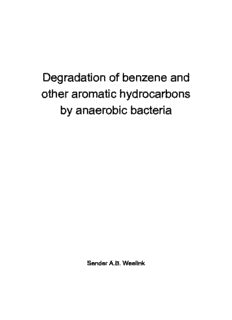
Degradation of benzene and other aromatic hydrocarbons by anaerobic bacteria PDF
Preview Degradation of benzene and other aromatic hydrocarbons by anaerobic bacteria
Degradation of benzene and other aromatic hydrocarbons by anaerobic bacteria Sander A.B. Weelink Promotoren Prof. dr. ir. A.J.M. Stams Persoonlijk hoogleraar bij het Laboratorium voor Microbiologie Wageningen Universiteit Promotiecommissie Dr. ir. H.H.M. Rijnaarts TNO Bouw en Ondergrond/Deltares, Utrecht Prof. dr. P.C. de Ruiter Wageningen Universiteit Prof. dr. D. Springael Katholieke Universiteit Leuven, België Prof. dr. H.J. Laanbroek Nederlands Instituut voor Ecologie (NIOO-KNAW), Nieuwersluis Dit onderzoek is uitgevoerd binnen de onderzoekschool WIMEK/SENSE Degradation of benzene and other aromatic hydrocarbons by anaerobic bacteria Sander A.B. Weelink Proefschrift ter verkrijging van de graad van doctor op gezag van de rector magnificus van Wageningen Universiteit, Prof. dr. M.J. Kropff, in het openbaar te verdedigen op dinsdag 18 november 2008 des namiddags te vier uur in de Aula Degradation of benzene and other aromatic hydrocarbons by anaerobic bacteria Sander A.B. Weelink PhD thesis Wageningen University, Wageningen, The Netherlands (2008) 128 pages, with summary in Dutch ISBN 978-90-8585-239-1 Voor Pa en Ma Abstract Accidental spills, industrial discharges and gasoline leakage from underground storage tanks have resulted in serious pollution of the environment with monoaromatic hydrocarbons, such as benzene, toluene, ethylbenzene and xylene (so-called BTEX). High concentrations of BTEX have been detected in soils, sediments and groundwater. The mobility and toxicity of the BTEX compounds are of major concern. In situ bioremediation of BTEX by using naturally occurring microorganisms or introduced microorganisms is a very attractive option. BTEX compounds are known to be transformed (or degraded) by microorganisms under aerobic and anaerobic conditions. As BTEX compounds are often present in the anaerobic zones of the environment, anaerobic bioremediation is an attractive remediation technique. The bottleneck in the application of anaerobic techniques is the lack of knowledge about the anaerobic biodegradation of benzene. In particular, little is known about the bacteria involved in anaerobic benzene degradation and the anaerobic benzene degradation pathway has still not been elucidated. The aim of the research presented in this thesis was to gain more insight in the degradation of benzene and other aromatic hydrocarbons by anaerobic bacteria. In particular, the physiology and phylogeny of the bacteria responsible for the degradation were studied and the results have been presented in this thesis. Anaerobic benzene and toluene degradation was studied with different electron acceptors in batch experiments inoculated with material from an aquifer polluted by BTEX-containing landfill leachate (Banisveld landfill near Boxtel, The Netherlands). Benzene was not degraded during one year of incubation. Toluene degradation, on the other hand, was observed with nitrate, MnO and Fe(III)NTA 2 as electron acceptors. After further enrichment and several isolation attempts, a novel betaproteobacterial bacterium, strain G5G6, was obtained in pure culture. Strain G5G6 is able to grow with toluene as the sole electron donor and carbon source, and amorphous and soluble Fe(III)- species, nitrate and MnO as electron acceptors. Strain G5G6 has several other interesting 2 physiological and phylogenetic characteristics, which will be subject of future research. Strain G5G6 represents a novel species in a novel genus for which we propose the name Georgfuchsia toluolica. In general, aerobic degradation of BTEX is a faster process than anaerobic BTEX degradation. However, for a number of reasons application of oxygen-dependent processes in the subsurface are technically and financially often not appealing. Therefore, an alternative bioremediation strategy would be to introduce oxygen in an alternative way, e.g. by in situ production. Chlorate reduction is a way to produce molecular oxygen in situ under anaerobic conditions. The formation of oxygen during chlorate reduction may result in rapid oxidation of compounds which are slowly degraded under anaerobic conditions; an example of such a compound is benzene. Therefore, benzene degradation coupled to the reduction of chlorate (ClO -) was studied in this thesis. With mixed material from a wastewater 3 treatment plant and soil samples obtained from a location contaminated with benzene, a benzene- degrading chlorate-reducing stable enrichment culture was obtained. This stable enrichment consisted of about five different bacterial species. Cross feeding involving interspecies oxygen transfer is a likely mechanism in this enrichment. One of these species, strain BC, was obtained in pure culture. Phylogenetic analysis showed that strain BC is a Alicycliphilus denitrificans strain. Strain BC is able to degrade benzene in conjunction with chlorate reduction. Oxygenase genes putatively encoding the enzymes performing the initial steps in aerobic degradation of benzene, were detected in strain BC. This demonstrates the existence of aerobic benzene bacterial biodegradation pathways under essentially anaerobic conditions. Thus, aerobic pathways can be employed under conditions where no external oxygen is supplied. The new insights into toluene degradation under anaerobic conditions and benzene degradation coupled to chlorate reduction, as described in this thesis, can be applied for the improvement or development of in situ bioremediation strategies for BTEX contamination. Table of contents Chapter 1 General introduction 1 Chapter 2 Anaerobic benzene and toluene biodegradation studies with different electron acceptors in contaminated aquifer microcosms 27 Chapter 3 Anaerobic degradation of aromatic hydrocarbons with Fe(III), Mn(IV) or nitrate by the Betaproteobacterium, Georgfuchsia toluolica, gen. nov., sp. nov. 41 Chapter 4 Physiological and phylogenetic characterization of a stable benzene-degrading, chlorate-reducing microbial community 59 Chapter 5 Isolation and characterization of Alicycliphilus denitrificans strain BC, which grows on benzene with chlorate as the electron acceptor 73 Chapter 6 Physiological characterization of two Alicycliphilus denitrificans strains 91 Chapter 7 General discussion and summary 95 Nederlandse samenvatting 106 References 110 List of publications 122 Curriculum vitae 123 Dankwoord 124 WIMEK/SENSE certificate 126
Description: